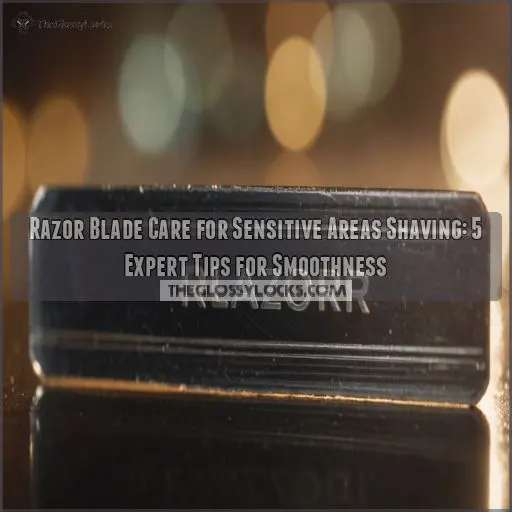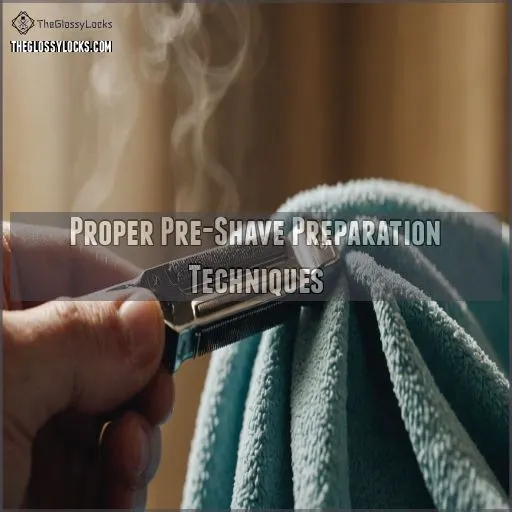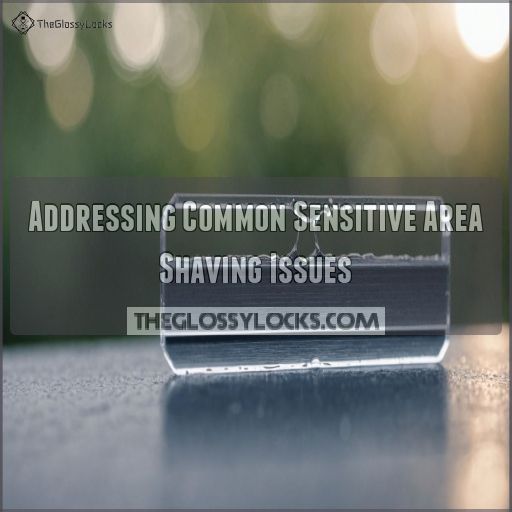This site is supported by our readers. We may earn a commission, at no cost to you, if you purchase through links.
 Taking care of your razor blade when shaving sensitive areas is as important as a chef sharpening their knives. Choose wisely between single or multi-blade razors, as they can make or break your shaving experience—especially when sensitive skin is involved.
Taking care of your razor blade when shaving sensitive areas is as important as a chef sharpening their knives. Choose wisely between single or multi-blade razors, as they can make or break your shaving experience—especially when sensitive skin is involved.
Before you start, cleanse and exfoliate those areas like you’re prepping for a spa day, soften the hair with warm water, and consider a layer of pre-shave oil.
After your shave, think of your razor as a prized chef’s knife: rinse it well, dry it, and store it properly. Avoiding irritation can be your secret ingredient to smoother skin!
Next, explore perfecting your technique.
Table Of Contents
Key Takeaways
- Choose your razor wisely, like a chef picking their knives. Single-blade razors are gentle on sensitive skin, while multi-blade razors offer a closer shave but might increase irritation. It’s like Goldilocks—find what’s just right for you.
- Prep your skin as if you’re getting ready for a spa day. Cleanse, exfoliate, and use pre-shave oils. It’s the secret sauce to a smooth shave and happy skin—because nobody wants ouch moments!
- Master the shaving angle and pressure. Hold your razor at a 30-degree angle and let its weight do the work. Think of it as a dance move—graceful and light to avoid stumbles and skin drama.
- Post-shave, treat your razor like a prized chef’s knife. Rinse, dry, and store it properly. It’s not just blade care; it’s the secret to extending its life and keeping your skin irritation-free.
Choosing the Right Razor for Sensitive Areas
When shaving sensitive areas, choosing the right razor can make all the difference in achieving a smooth, irritation-free result for shaving sensitive areas.
Let’s explore the key factors that matter, from safety razors vs. cartridge options to the importance of ergonomic handles and specialized designs for different body parts.
Safety Razors Vs. Cartridge Razors
Choosing between safety razors and cartridge razors for sensitive areas can be tricky. Here’s what you need to know:
- Blade sharpness: Safety razors offer a closer shave, but require more skill.
- Cost comparison: Cartridges are pricier long-term, while safety razors have higher upfront costs.
- Learning curve: Cartridges are user-friendly; safety razors need practice.
- Environmental impact: Safety razors produce less plastic waste.
Remember, finding your perfect match might take some trial and error!
Single-blade Vs. Multi-blade Options
Now, let’s talk about blade count. You’ve got two options: single-blade or multi-blade razors.
Single blades offer precision and less irritation, perfect for those with sensitive skin. They’re like a gentle caress for your delicate areas.
Multi-blades, on the other hand, provide a closer shave but might increase irritation risk. Consider your skin type and shaving frequency when choosing. Remember, more blades don’t always mean better results!
Importance of Razor Handle Ergonomics
The right razor handle can make or break your shaving experience.
You’ll want to find a balance between grip comfort and razor weight that feels like an extension of your hand.
A well-designed handle helps with proper blade alignment and reduces user fatigue, especially in those hard-to-reach spots.
Don’t underestimate the importance of handle length – it can be a game-changer for tricky angles.
Remember, a comfortable grip means smoother strokes and happier skin.
Specialized Razors for Different Body Parts
You’ve got the handle on comfort, but let’s shave off some confusion about specialized razors.
Different body parts need different tools.
Your face isn’t your legs, and your bikini line certainly isn’t your armpits!
Consider these razor recommendations:
- Bikini line: Compact head for precision (like threading a needle)
- Legs: Wide, pivoting head (think lawn mower for your limbs)
- Underarms: Flexible, multi-directional (imagine a contortionist razor)
Remember, the right tool makes all the difference in your smooth-skin quest!
Proper Pre-Shave Preparation Techniques
Preparing your skin before shaving sensitive areas is really important for a smooth, irritation-free experience.
You’ll want to focus on cleansing, exfoliating, and softening the hair to set yourself up for success and avoid any ouch-worthy moments.
Cleansing and Exfoliating Sensitive Skin
Kick off your shaving routine by pampering your sensitive skin with a gentle, hypoallergenic soap. a gentle, hypoallergenic soap. Gently cleanse the area with a mild, fragrance-free soap to remove dirt and oils.
Next, exfoliate with a soft-bristled brush or gentle scrub to lift dead skin cells and prevent ingrown hairs.
This prep work sets the stage for a smoother shave, but remember: treat your delicate areas like fine china – with care and attention.
Applying Pre-shave Oils or Creams
Now that your skin’s fresh and clean, let’s talk about the magic of pre-shave products. These slick helpers create a protective barrier, reducing friction and irritation.
Here’s a quick rundown:
- Massage a dime-sized amount into your skin
- Choose oils for extra glide, creams for more cushion
- Look for natural ingredients like jojoba or aloe vera
- Give it a minute to absorb before lathering up
Think of it as buttering your toast – everything’s smoother with the right prep!
Softening Hair With Warm Water
After prepping with oils or creams, let’s talk about the magic of warm water. It’s like giving your hair a relaxing spa day! Warm water (not scalding hot) opens up those stubborn follicles, making your hair softer and more pliable. Think of it as coaxing your hair to cooperate.
For best results, try a warm shower or hold a damp washcloth against the area for a few minutes.
Trimming Longer Hair Before Shaving
Before diving into shaving sensitive areas, trimming longer hair is a key step you shouldn’t skip. It’ll make your shaving experience smoother and reduce the risk of irritation.
Here are some key points to remember:
- Use clean, sharp trimming tools
- Aim for a hair length of about 1/4 inch
- Trim in the direction of hair growth
- Be extra gentle around delicate skin
- Apply a soothing lotion post-trim
Think of it as mowing the lawn before using the weed whacker – a little prep goes a long way!
Effective Shaving Techniques for Delicate Regions
Mastering the art of shaving sensitive areas requires finesse and the right techniques.
You’ll discover expert tips for achieving a smooth, irritation-free shave in those delicate regions, from proper razor handling to skin preparation tricks that’ll make you wonder why you ever dreaded the task for a smooth shave.
Proper Razor Angle and Pressure
Getting the right razor angle and pressure is really important for a smooth, irritation-free shave in sensitive areas. Hold your razor at a 30-degree angle to your skin, letting the blade’s weight do the work. Avoid pressing too hard, which can lead to nicks and razor burn. Here’s a quick guide to help you perfect your technique:
| Angle | Pressure | Result |
|---|---|---|
| Too steep | Too heavy | Ouch! Cuts galore |
| Just right | Light touch | Silky smooth skin |
| Too shallow | Too light | Stubble city |
Shaving Direction for Different Areas
Now that you’ve got the right angle and pressure, let’s talk about shaving direction. It’s not one-size-fits-all!
On your face, go with the grain first.
For body hair, like legs or arms, against the grain usually works best.
For sensitive spots like the groin or armpits, start with the grain and only go against if necessary.
Remember, everyone’s hair grows differently, so experiment to find what works for you.
Stretching Skin for a Closer Shave
Precision is key for achieving a closer shave in sensitive areas.
To maximize smoothness, gently pull your skin taut with your free hand. This creates a flatter surface for your razor to glide over, reducing the risk of nicks and cuts.
Remember, different body parts may require unique stretching techniques. For instance, you’ll stretch your underarm differently than your bikini line.
Always move with care and listen to your skin’s needs.
Rinsing the Blade Between Strokes
After stretching your skin, don’t forget to keep that blade squeaky clean!
Rinse it between strokes to avoid turning your sensitive spots into a hair and gunk playground.
A quick swish under warm water does wonders, washing away shaving cream residue and stubborn stubble.
This simple step keeps your blade gliding smoothly, reducing the risk of nicks and irritation.
Your skin will thank you!
Post-Shave Care and Blade Maintenance
After a close shave in sensitive areas, taking care of your razor is just as important as caring for your skin.
You wouldn’t reuse a dirty fork, so why risk an unclean blade?
Rinsing and Drying the Razor Thoroughly
After shaving, it’s important to thoroughly rinse and dry your razor. This helps prevent blade rust, bacteria buildup, and extends the life of your razor.
- Rinse the blade under warm running water to wash away any shaving cream, hair, or skin cells.
- Gently pat the razor dry with a clean, soft cloth.
- Allow the razor to air dry completely before storing.
Applying Alcohol or Blade Oil
Your razor’s had a wild ride—show it some love! Applying alcohol or blade oil can keep it keen.
Alcohol’s a ninja killing germs, while oil’s a superhero preventing rust.
Dab a little on after each shave, and your blades stay sharp longer.
Pick your ally: sterilizer or protector?
Either way, your skin (and razor) will thank you!
Proper Blade Storage Techniques
Storing your razor properly is important for blade longevity.
A cheerful blade says, "Keep me dry!" Avoid dampness and rust!
Choose storage containers that minimize blade exposure.
You might picture your razor lounging in a comfy, dry spot.
Rust is like an uninvited guest, so make sure the blade’s dry hotel is spotless.
Trust me, your smooth shave deserves it.
Frequency of Blade Replacement
Keeping your razor sharp and skin happy isn’t rocket science. In fact, knowing when to swap blades is like learning to dance—find the rhythm. Here’s the scoop:
- Use sharpness as your guide
- Pay attention to discomfort
-
Watch for signs of dullness
- Balance cost vs. quality
- Typically change every 5-10 shaves
Your skin will thank you!
Addressing Common Sensitive Area Shaving Issues
Shaving sensitive areas can be tricky, but don’t worry – we’ve got your back.
In this section, we’ll cover expert tips to prevent common issues like razor burn, ingrown hairs, and skin irritation.
So you can achieve a smooth, comfortable shave every time.
Preventing Razor Burn and Ingrown Hairs
You’ve just tackled post-shave care like a pro; now, let’s ward off razor burn and nasty ingrown hairs.
Use rich shaving creams and be sure to exfoliate regularly.
Hot water softens those stubborn hairs, reducing razor bumps.
Don’t skimp on moisturizing afterwards either! It’s like giving your skin a high-five for a job well done.
Treating Nicks and Cuts
Nick yourself shaving? Don’t fret. First, apply gentle pressure with a clean cloth to control bleeding.
For home remedies, dab a bit of antiseptic.
Prevent scars by using a soothing balm.
Remember, it’s not a horror movie—keep it calm!
Next time, steady hands and slow strokes are your friends.
Razor mayhem solved!
Managing Skin Irritation and Redness
Nicks and cuts are pesky, but let’s chat about the next hurdle: managing skin irritation and redness. Ever feel like your skin’s throwing a tantrum?
Here’s how to soothe it:
- Use calming skincare products like soothing balms.
- Test natural remedies, like aloe vera.
- Identify and eliminate irritation triggers.
- Evaluate your shaving frequency—it’s a game-changer.
Keep calm and shave on!
Adapting Techniques for Different Skin Types
Your skin type plays a big role in how you shave sensitive areas.
If you have dry skin, use a moisturizing shave cream and shave with the grain.
For oily or acne-prone skin, opt for a gel-based formula and shave against the grain.
Those with sensitive skin should go easy, use a single-blade razor, and apply a soothing post-shave balm.
Frequently Asked Questions (FAQs)
How often should razor blades be replaced?
Ah, the delicate dance of blade maintenance!
Swap out those trusty companions every 5-7 shaves to keep your skin silky smooth and avoid any unwelcome surprises.
A fresh edge makes all the difference, don’t you agree?
Are electric razors suitable for sensitive skin?
Electric razors can be a boon for sensitive skin, minimizing nicks and cuts compared to traditional razors.
Models like the Panasonic Arc5 and Braun Series 5 offer specialized features, providing both comfort and control during your shaving escapades.
Can shaving cream affect razor performance?
Think shaving cream’s just fluff? It’s a secret ninja, fighting friction, keeping razors sharp as new.
The rich, creamy lather reduces blade wear, making them glide like a hot knife through butter while protecting sensitive skin from irritation (Source).
What are alternative hair removal methods?
You’ve got several alternatives to shaving.
Waxing plucks hair from the root while sugaring offers a natural twist.
Laser and electrolysis target follicles for lasting effects.
Depilatory creams dissolve hair quickly, albeit temporarily (Source).
How to store razors for longevity?
Razor blades are like your best buds – treat ’em right, and they’ll stick around forever!
Stash ’em in a dry, cool spot, and they’ll be sharper than a samurai’s sword, ready to tackle even the toughest stubble.
Conclusion
Nearly 60% of people with sensitive skin report experiencing irritation when shaving. Don’t let that be you.
With the right razor blade care for sensitive areas shaving, you’ll turn potential disasters into delightful daily rituals.
Choose your razor like a chef selects knives, pamper your skin pre-shave, and master the perfect technique.
Post-shave care seals the deal.
Remember, a well-maintained razor is your ally in achieving smooth, irritation-free skin every time you shave.
Happy shaving!








